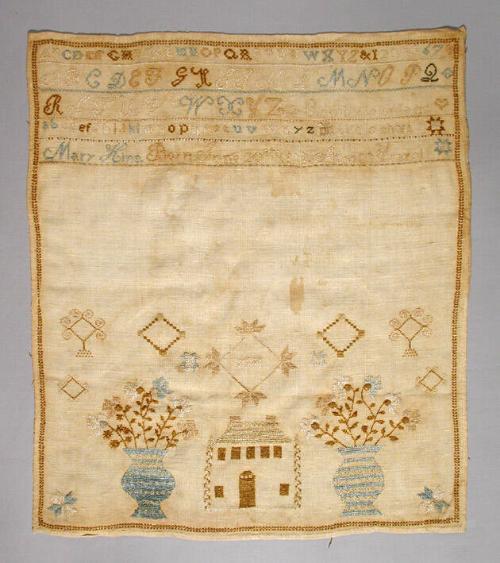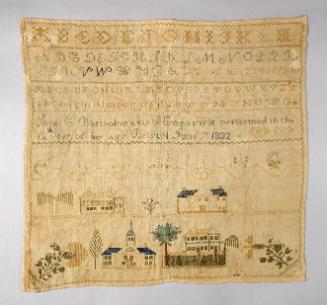Sampler
EmbroidererEmbroidered by
Mary Hine
(American, born 1819)
TeacherTaught by
Mary A. Hotchkiss
Date1832-1833
MediumEmbroidery; silk threads on a plain-woven, undyed linen ground
DimensionsPrimary Dimensions (height x width): 15 1/4 x 13 1/4in. (38.7 x 33.7cm)
ClassificationsTextiles
Credit LineGift of Helen A. Boxwell
Object number1985.106.0
DescriptionSampler worked in light blue, dark salmon, pink, medium blue, dark brown, light brown, cream, and dark green silk threads on a plain-woven linen ground in cross and other stitches. The sampler is squarish, oriented vertically. It is laid out with four rows of three alphabets, the numbers 1 through 8, and an inscription, over an inscription, over two horizontal bands of pictorial motifs. The first inscription is "Eternity is long and/ Life is short". The second inscription is "Mary Hine Born June 20th 18[??] Aged 13 Years". The last two digits in maker's birth year are picked out. The first row of pictorial motifs includes, from left to right, two marking motifs, an eight-pointed star, a large diamond containing the initials "MH" with each point having a four-pointed half star or leaf design coming from it, an eight-pointed star, and two marking motifs. The second horizontal row of pictorial motifs includes, from left to right, an eight-pointed star, a large vase of flowers, a two-story house with center door, a widows walk, two chimneys, and two spires, a large vase of flowers, and an eight-pointed star. The motifs are not to scale. There are several small star, diamond, and heart designs throughout the piece. The lines of alphabets and text are separated by various narrow borders, including straight and meandering lines. There is a narrow four-sided border. The sampler is probably unfinished.
The sampler has a 1/8- to 3/16-inch double-turned hem on all four sides. The sampler is not framed.
Letters and Numbers: There are three alphabets. The letters are uppercase block in alphabet 1, uppercase script in alphabet 2, and lowercase block in alphabet 2. The letters J and U are present in all alphabets.
Stitches: The principal stitch on the sampler is cross over two threads; it is also worked in chain, back, and cross (over three threads) stitches.
Condition: The sampler has light to severe fading, depending on color. The sampler has several stains, especially at the top and center. The sampler is not framed.
The sampler has a 1/8- to 3/16-inch double-turned hem on all four sides. The sampler is not framed.
Letters and Numbers: There are three alphabets. The letters are uppercase block in alphabet 1, uppercase script in alphabet 2, and lowercase block in alphabet 2. The letters J and U are present in all alphabets.
Stitches: The principal stitch on the sampler is cross over two threads; it is also worked in chain, back, and cross (over three threads) stitches.
Condition: The sampler has light to severe fading, depending on color. The sampler has several stains, especially at the top and center. The sampler is not framed.
Label TextAt the bottom of Mary Hine’s sampler, two large bouquets of flowers
tower fantastically over a two-story house. Close examination reveals that
Mary’s sampler is more sophisticated than it first appears. The stitching
is small and precise, worked on a finer-than-usual linen ground. The colors
have faded (the reverse is much brighter). The two vases have different
profiles and surface patterns, created by stripes of tiny, solidly worked blue
cross-stitches alternating with open lozenge shapes that were originally a
bright pink. The blank space between the existing text and the geometric
figures was presumably intended for a verse. The initials “MH,” in the
diamond above the house, probably correspond to the name of the maker’s
teacher, Mary Hotchkiss of Salem, Connecticut, based on another sampler
with a similar “MH” emblem.
tower fantastically over a two-story house. Close examination reveals that
Mary’s sampler is more sophisticated than it first appears. The stitching
is small and precise, worked on a finer-than-usual linen ground. The colors
have faded (the reverse is much brighter). The two vases have different
profiles and surface patterns, created by stripes of tiny, solidly worked blue
cross-stitches alternating with open lozenge shapes that were originally a
bright pink. The blank space between the existing text and the geometric
figures was presumably intended for a verse. The initials “MH,” in the
diamond above the house, probably correspond to the name of the maker’s
teacher, Mary Hotchkiss of Salem, Connecticut, based on another sampler
with a similar “MH” emblem.
Status
Not on view
















